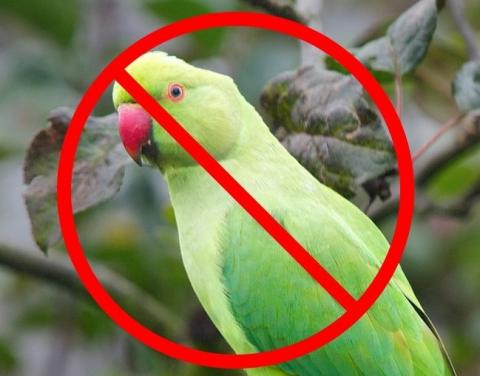
Seychelles has made history in becoming the first country ever to eradicate an established population of the invasive ring-necked parakeet (Psittacula krameri) from the wild. The last known wild ring-necked parakeet was culled in the Morne Blanc region of Mahé in August 2017 and with no evidence of any remaining wild birds in over a year and a half - and the final phase of follow-up monitoring completed - this ground-breaking eradication can now be declared successful. Seychelles’ Minister of Environment, Minister Cosgrow, stated that “The eradication of the ring-necked parakeet is a remarkable achievement for a small country like the Seychelles which strives to protect its native biodiversity from invasive alien species. The collaborative efforts of the Seychelles Islands Foundation, the Government through the Ministry of Environment Energy and Climate Change and other government agencies, NGOs and the public, is testament of what can be achieved when we work together for the benefit of our environment. Through our dedication, hard work and consistency, we continue to show the world that we are true pioneers in environmental protection. The invaluable experiences gained from this programme can now be shared with other countries who are yet to achieve this kind of success.”
Over 500 ring-necked parakeets, or ‘kato ver’, have been culled since project inception, and prior to August 2017 the last one was shot in May 2016. The ring-necked parakeet is one of the worst invasive species in the world; it is the most widely introduced parrot species, with breeding populations in nearly 40 countries outside of its native range. Where it is introduced it poses threats to native biodiversity. In Seychelles the parakeets posed a major threat to Seychelles’ national bird, the endemic Seychelles black parrot. Although the ring-necked parakeets were restricted to Mahé, with one individual culled on Silhouette, if they had established a population on Praslin they would probably have aggressively competed with black parrots for food and nesting sites. Moreover, the ring-necked parakeet has been implicated in introducing diseases that have threatened other native parrot populations, such as the echo parakeets (Psittacula eques) in Mauritius. The ring-necked parakeet eradication was initiated to prevent the same from happening in Seychelles to the Seychelles black parrot.
The importance of the eradication was confirmed in September 2018 with the publication of key research confirming the presence of beak and feather disease virus (BFDV) in ring-necked parakeets on Mahé. The research analysed blood samples collected by the Seychelles Islands Foundation from 24 black parrots on Praslin and 23 ring-necked parakeets on Mahé. All of the black parrot samples tested negative for BFDV, but the virus was detected in nearly 50% of the ring-necked parakeet samples. Another important finding was that the strain of BFDV found in Seychelles was most closely related to the UK strain, suggesting that the virus entered the country - and subsequently infected the wild ring-necked parakeet population - by way of a parrot or parakeet imported from the UK. Although it is extremely worrying that the wild ring-necked parakeets on Mahé were carriers of the BFDV, their eradication has given the Seychelles black parrot their best chance at remaining BFDV free.
An earlier attempt to eradicate the ring-necked parakeet from Seychelles was made by the Department of Environment in the early 2000s. Since 2011 SIF has led the national initiative to eradicate the species from the wild in Seychelles, which has been done in full collaboration with the Ministry of Environment, Energy and Climate Change, the Seychelles Police Force and the Seychelles People’s Defence Force. Their support, combined with funding from the European Union, the Environment Trust Fund Seychelles, and the Global Environment Facility, secured the success of the eradication. An essential part of the eradication has been the public information campaign, with members of the public supporting the team and providing information on parakeet sightings throughout the project. This has been of vital importance at every stage, especially in targeting the last elusive birds. After a long eradication effort all those involved, including the dedicated members of the public, have achieved a remarkable feat and the world will increasingly look to Seychelles as pioneers in invasive species management.






